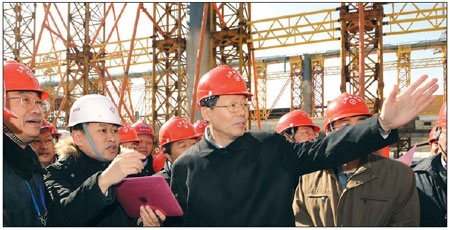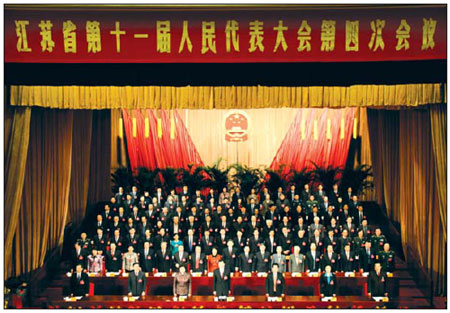News
Giving people a better life is crucial
By Xu Xiao (China Daily)
Updated: 2011-03-05 07:37
 |
Large Medium Small |
|
Jiangsu Governor Li Xueyong (center), inspects the Nanjing South Station, a key part of the Beijing-Shanghai High-speed Railway which is now under construction, on Dec 31, 2010. |
|
Opening ceremony of the fourth plenary session of the 11th Provincial People's Congress of Jiangsu held on Feb 10, in Nanjing. Photos Provided to China Daily |

Governor looks forward to bright future, built on province's remarkable past
The last five years have been significant for Jiangsu province because it dealt well with the world financial crisis, moved ahead in social, economic and cultural development, and reached the goals it had set, the governor Li Xueyong recently remarked.
Li made the comment in a work report at the province's fourth plenary session of the 11th People's Congress, which was held in February.
Li was summarizing both the achievements and mistakes of the 11th Five-Year Plan (2006-2010), and giving an outline for future development.
When the financial crisis hit, the province followed the Chinese government's idea of increasing domestic demand to maintain economic growth, he explained.
In doing so, it gave financial support to small and medium-sized companies and boosted international trade. Jiangsu's GDP reached 4.09 trillion yuan in 2010, or 13.5 percent more than the previous year.
And per capita GDP grew from $3,046 in 2006 to $7,700 in 2010. Retail sales amounted to 1.3 trillion yuan, an 18.6 percent increase over 2009, Li said, noting that consumer spending was the economy's biggest driving force.
Fixed assets investments amounted to 2.31 trillion yuan, up 21.5 percent from the previous year.
Imports and exports also saw growth, totaling 465.8 billion yuan, with exports contributing 270.6 billion of that.
Basic infrastructure like electric power stations, highways, ports, and airports contributed a lot to the development, the governor said.
So, this period was essential to improving the province's economic and industrial structures and to modernizing traditional industries and supporting emerging ones.
Emerging industries
Emerging industries are leading to another round of economic growth. Their output value, in 2010, accounted for 33 percent of that of pillar industries.
Six major emerging industries are new energy, new materials, biological technology, new medicines, and software. These generated sales revenues of more than 2 trillion yuan, or 23 percent of all industrial output.
Added value in the service sector accounted for more than 40 percent of the region's production value, and 5.1 percentage points higher than under the 10th Five-Year Plan (2001-2005).
The province also showed some progress in environment protection, with the water quality of its major lake - Taihu - improving markedly.
The forest-coverage rate grew 20.6 percent, and the amount of urban green areas, 42 percent.
Regional development
Over the past five years, Jiangsu also narrowed the gap between urban and rural levels of development.
Li said they had solved the drinking water safety problem for 12.75 million rural people. They also moved 2.27 million rural people to towns to provide more job opportunities for them.
This helped improve the local economy, adding 28 towns to China's top 100 rich towns list.
The northern part of the province, which is relatively behind, when compared to the southern and central parts, saw some improvement as well.
It had over 10,000 projects involving more than 5 million yuan each and the major economic indexes were above average for the province, over the past five-year period.
As the northern part improved, it meant that all of Jiangsu could enjoy the prosperity of the Yangtze River Delta region. Even coastal areas of southern Jiangsu were able to join the national development strategy.
Standard of living
During the past five years, income levels in Jiangsu have gone up, Li said.
In 2010, the annual income of urbanites reached 22,944 yuan, a 10.2-percent rise from 2009, while the net income of rural people reached 9,118 yuan, an 8.2-percent rise.
In the same period, 5.87 million more people found jobs in urban areas, and the unemployment rate was held to within 3.5 percent.
The province also added more living space for low-income families and provided stipends as well. Meanwhile, 3.62 million rural people rose above the poverty line.
Education
Education also found itself on the forefront of development, with free compulsory education reaching both urban and rural areas, Li said. High-school education is now almost universal and vocational training is undergoing a sort of boom.
The province has seen good development in sports as well and, at the common level, it has provided more places for people to exercise.
In addition, the capital city, Nanjing, held the 17th provincial sports meeting last year and won the bid of hosting the second Youth Olympics in 2014 .
In the area of popular culture, Jiangsu has done its best to build more harmonious communities. It also increased market controls to guarantee food and medicine safety.
The governor added that the rights of women, children, the elderly, and the disabled are being looked after. And charity drives are one means of accomplishing that and making life better for the needy.
Looking to the future
Nonetheless, Li said, even with the major achievements of the past five years, they are not without their problems, which need to be addressed in the next period.
He said they need to maintain a "scientific developmental outlook", proposed by President Hu Jintao, a major guideline of the Communist Party.
The province also needs to push its reforms and opening up to create more development opportunities, said Li.
In this, improving the economic structure is essential. But, the government needs to concentrate on harmonious development between urban and rural areas, and between human beings and the environment.
In the end, Li said, allowing people to enjoy a better life is the most important task that lies ahead.
(China Daily 03/05/2011 page11)
| 分享按钮 |

